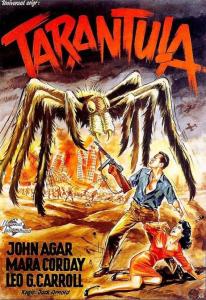Tarantula

Tarantula (1955): A Towering Testament to 1950s Sci-Fi Cinema
In the golden era of 1950s science fiction, Tarantula (1955) emerges as a quintessential example of the genre's fascination with the consequences of unchecked scientific ambition. Directed by Jack Arnold, renowned for Creature from the Black Lagoon and The Incredible Shrinking Man, this film weaves a narrative that is both thrilling and cautionary.
Plot and Themes
Set against the arid backdrop of Desert Rock, Arizona, the story follows Dr. Matt Hastings (John Agar) as he investigates a series of mysterious deaths linked to Professor Gerald Deemer's (Leo G. Carroll) experiments with a growth serum intended to solve world hunger. The unintended consequence: a tarantula that escapes and grows to monstrous proportions, threatening the very fabric of the community.
The film delves into themes of scientific hubris and the unforeseen ramifications of playing god, common motifs in post-war American cinema reflecting societal anxieties of the atomic age.
Cast and Performances
John Agar delivers a solid performance as the inquisitive Dr. Hastings, embodying the archetypal 1950s hero. Mara Corday portrays Stephanie Clayton, Deemer's assistant, bringing both intelligence and resilience to her role. Leo G. Carroll's depiction of Professor Deemer adds depth, portraying a man torn between scientific pursuit and moral responsibility.
Notably, a young Clint Eastwood appears uncredited as a jet squadron leader, marking one of his earliest film roles.
Direction and Cinematography
Jack Arnold's direction ensures a tight narrative pace, balancing character development with suspenseful sequences. The cinematography by George Robinson captures the starkness of the desert setting, enhancing the film's tension.
Special Effects
For its time, Tarantula boasts impressive special effects. The use of a real tarantula composited into scenes with miniatures creates a convincing illusion of scale, a testament to the ingenuity of 1950s filmmaking techniques.
Legacy and Availability
While Tarantula remains under copyright by Universal City Studios and is not in the public domain, it has been preserved and is accessible through various platforms. The film's enduring appeal lies in its effective storytelling, competent performances, and its reflection of contemporary societal fears.
Conclusion
Tarantula stands as a significant entry in the canon of classic science fiction cinema. Its exploration of the perils of scientific overreach, combined with compelling performances and innovative effects, ensures its place in film history. For enthusiasts of vintage sci-fi and those interested in the cultural zeitgeist of the 1950s, Tarantula offers both entertainment and insight.







